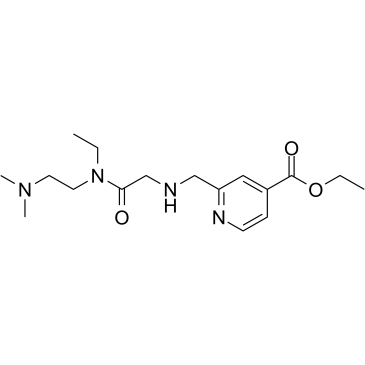| Cas No.: | 1596348-32-1 |
| Chemical Name: | Ethyl 2-(((2-((2-(dimethylamino)ethyl)(ethyl)amino)-2-oxoethyl)amino)methyl)isonicotinate |
| Synonyms: | KDM5 inhibitor C70 |
| SMILES: | O=C(OCC)C1C=CN=C(CNCC(=O)N(CC)CCN(C)C)C=1 |
| Formula: | C17H28N4O3 |
| M.Wt: | 336.43 |
| Purity: | >98% |
| Sotrage: | 2 years -20°C Powder, 2 weeks 4°C in DMSO, 6 months -80°C in DMSO |
| Publication: | [1]. Johansson C, et al. Structural analysis of human KDM5B guides histone demethylase inhibitor development. Nat Chem Biol. 2016 Jul;12(7):539-45. [2]. Blair LP, et al. KDM5 lysine demethylases are involved in maintenance of 3'UTR length. Sci Adv. 2016 Nov 18;2(11):e1501662. |
| Description: | KDM5-C70 is an ethyl ester derivative of KDM5-C49 and a potent, cell-permeable and pan-KDM5 histone demethylase inhibitor. KDM5-C70 has an antiproliferative effect in myeloma cells, leading to genome-wide elevation of H3K4me3 levels[1][2]. |
| Target: | KDM5 histone demethylase[1][2] |
| In Vitro: | KDM5-C70 (10-9-10-5 M; 7 days; MM.1S myeloma cells) treatment shows antiproliferative effects after 7 days of treatment at elevated concentrations (estimated 50% reduction of viability/proliferation for KDM5-C70 at ~20 μM)[1]. KDM5-C70 (50 μM; 7 days; MM.1S myeloma cells) treatment decreases the level of phosphorylation of retinoblastoma protein (Rb), while leaving the total level of phosphorylated Rb (pRb) unchanged, indicating impairment of cell cycle progression[1]. Chromatin immunoprecipitation followed by next-generation sequencing shows an increase in H3K4me3 levels around transcription start sites with KDM5-C70 but little change with GSK467A at 50 μM inhibitor concentrations[1]. Cell Viability Assay[1] Cell Line: MM.1S myeloma cells Concentration: 10-9-10-5 M Incubation Time: 7 days Result: Showed antiproliferative effects after 7 days of treatment at elevated concentrations. Western Blot Analysis[1] Cell Line: MM.1S myeloma cells Concentration: 50 μM Incubation Time: 7 days Result: Decreased the level of phosphorylation of retinoblastoma protein (Rb). |
| References: | [1]. Johansson C, et al. Structural analysis of human KDM5B guides histone demethylase inhibitor development. Nat Chem Biol. 2016 Jul;12(7):539-45. [2]. Blair LP, et al. KDM5 lysine demethylases are involved in maintenance of 3'UTR length. Sci Adv. 2016 Nov 18;2(11):e1501662. |

 To enhance service speed and avoid tariff delays, we've opened a US warehouse. All US orders ship directly from our US facility.
To enhance service speed and avoid tariff delays, we've opened a US warehouse. All US orders ship directly from our US facility.




















